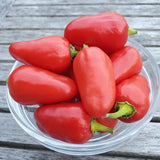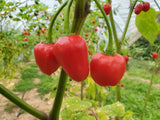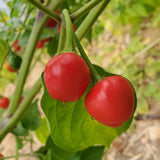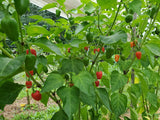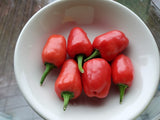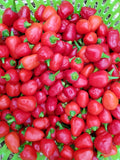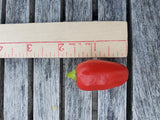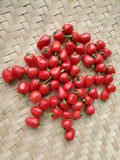Dalle Khorsani Pepper
Capsicum Annuum
Dalle Khorsani (“round chili”) Peppers are a special type of hot chilies grown in the hilly areas of Darjeeling and Sikkim. The peppers are small and round and turn red like cherries when ripe. The word Dallai means round in Nepali, and is often the name given to a short round kid! The plant grows into a shrub up to 5 feet in height and can last 5-6 years at the right climatic conditions. (I have mine for 6 years as I trim them and bring them in for the winter).
Dalle Khorsani is an important condiment for the Nepalis of the hilly region. It is often served as a hot sauce with their famous Momos (dumplings), and also pickled and preserved in Mustard oil, or made into chutney with mint or coriander and tomatoes.
We received seeds from Dr. Khem Fatimi, our friend Meena’s mom, a Nepali from Kalimpong, Darjeeling district in West Bengal, India. She grew up in a village where they did not have electricity and running tap water, and attended school with bare feet. More than half a century later, while working in Long Island, she has built a digital library in Kalimpong in her parents’ name to benefit the needy and also to educate local teachers in computer skills.
Dr. Fatimi shared these seeds with our mutual friends at Rise & Root Farm in Chester, NY. We sent the seeds to Johanna Rosen at Meadowhawk Farm in western Massachusetts since Jo works with farmers from Nepal.
Dr. Fatimi also shared a pepper sauce she made with roasted Dalle Khorsani. She adds canned mango or peach pulp to dilute the sauce.
Other names and spellings: Akabare, Akabare Khursani; Dalle, Dallay, Dallai, and Dallae Khursani.
Photos 1-8: by Meadowhawk Farm. Photos 9-11: by Dr. Khem Fatimi.
Days to maturity: 120
Seeds per pack: 10-15
Germination rate: 90% on 01/06/2025
Planting / harvesting notes
Start seeds indoors 8-10 weeks before the last frost and transplant into the garden well after the danger of frost. Keep seedlings moist but do not overwater. Transplants should be initially watered in well, and plants will be most productive with regular irrigation and full sun. Consider growing in large pots and taking them in for the winter - these plants can live for many years if properly cared for!
Seed keeping notes
Peppers are generally self-pollinating, though we isolate different varieties of the same species by at least 50 feet, in hopes that flying insects will not cross pollinate them unexpectedly. There are several important species of peppers, so check your scientific names! Pepper seeds are ripe when the fruits have turned their final fiery color - in this case, sunset-orange. Cut the fruit, scrape out seeds, and lay them out to dry on a labeled screen or paper product in a ventilated place away from direct sunlight for a week or two. Drying the peppers before seed extraction can slightly lower your germination rates, but works fine for home seed saving as long as the peppers do not rot.












